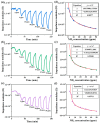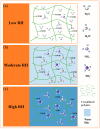Humidity-Activated Ammonia Sensor Based on Carboxylic Functionalized Cross-Linked Hydrogel
- PMID: 39771889
- PMCID: PMC11679150
- DOI: 10.3390/s24248154
Humidity-Activated Ammonia Sensor Based on Carboxylic Functionalized Cross-Linked Hydrogel
Abstract
Owing to its extensive use and intrinsic toxicity, NH3 detection is very crucial. Moisture can cause significant interference in the performance of sensors, and detecting NH3 in high humidity is still a challenge. In this work, a humidity-activated NH3 sensor was prepared by urocanic acid (URA) modifying poly (ethylene glycol) diacrylate (PEGDA) via a thiol-ene click cross-linking reaction. The optimized sensor achieved a response of 70% to 50 ppm NH3 at 80% RH, with a response time of 105.6 s and a recovery time of 346.8 s. The sensor was improved for response and recovery speed. In addition, the prepared sensor showed excellent selectivity to NH3 in high-humidity environments, making it suitable for use in some areas with high humidity all the year round or in high-humidity areas such as the detection of respiratory gas. A detailed investigation of the humidity-activated NH3-sensing mechanism was conducted using complex impedance plot (CIP) measurements.
Keywords: fast recovery; humidity-activated ammonia sensor; urocanic acid.
Conflict of interest statement
The authors declare no conflicts of interest.
Figures







Similar articles
-
Highly sensitive and chemically stable NH3 sensors based on an organic acid-sensitized cross-linked hydrogel for exhaled breath analysis.Biosens Bioelectron. 2021 Nov 1;191:113459. doi: 10.1016/j.bios.2021.113459. Epub 2021 Jun 22. Biosens Bioelectron. 2021. PMID: 34175649
-
A Highly Stable Two-Dimensional Copper(II) Organic Framework for Proton Conduction and Ammonia Impedance Sensing.Chemistry. 2018 Jul 25;24(42):10829-10839. doi: 10.1002/chem.201801844. Epub 2018 Jun 25. Chemistry. 2018. PMID: 29790210
-
Humidity activated ultra-selective room temperature gas sensor based on W doped MoS2/RGO composites for trace level ammonia detection.Anal Chim Acta. 2024 Jan 25;1287:342075. doi: 10.1016/j.aca.2023.342075. Epub 2023 Nov 30. Anal Chim Acta. 2024. PMID: 38182340
-
Flexible Room-Temperature NH3 Sensor for Ultrasensitive, Selective, and Humidity-Independent Gas Detection.ACS Appl Mater Interfaces. 2018 Aug 22;10(33):27858-27867. doi: 10.1021/acsami.8b09169. Epub 2018 Aug 8. ACS Appl Mater Interfaces. 2018. PMID: 30051712
-
Room temperature gas sensors for NH3 detection based on the heterojunction of 2D Ti3C2Tx MXenes and Bi2S3.Mikrochim Acta. 2024 Oct 22;191(11):687. doi: 10.1007/s00604-024-06750-1. Mikrochim Acta. 2024. PMID: 39433554
References
-
- Shetty S.S., Jayarama A., Bhat S., Karunasagar I., Pinto R. A Review on Metal-Oxide Based Trace Ammonia Sensor for Detection of Renal Disease by Exhaled Breath Analysis. Mater. Today-Proc. 2022;55:113–117. doi: 10.1016/j.matpr.2021.12.411. - DOI
-
- Wu H., Gong X., Tao W., Zhao L., Wang T., Liu F., Yan X., Sun P., Lu G. Humidity-Activated Ammonia Sensor Based on Mesoporous AlOOH Towards Breath Diagnosis. Sens. Actuators B Chem. 2023;380:133322. doi: 10.1016/j.snb.2023.133322. - DOI
Grants and funding
- 62171195/National Natural Science Foundation of China
- 62271227/National Natural Science Foundation of China
- 62301583/National Natural Science Foundation of China
- 20240402074GH/the Project of Science and Technology Development Plan of Jilin Province
- 2022T150252/the China Postdoctoral Science Foundation
LinkOut - more resources
Full Text Sources

